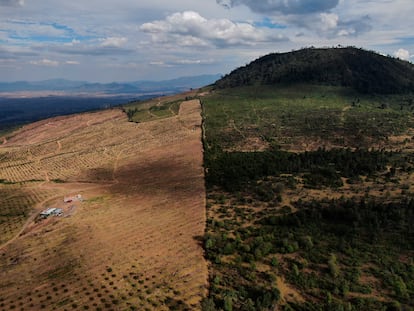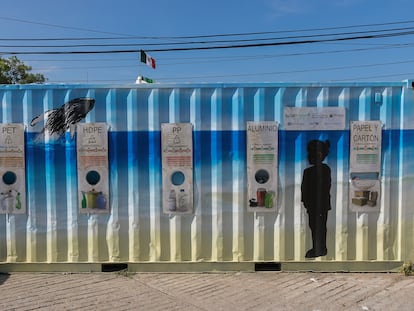Lack of access to clean water threatens Bajo Papaloapan, cradle of the Jarocha culture
Pollution in the Alvarado lagoon system, in the Mexican State of Veracruz, is jeopardizing the health and livelihood of the local fishing communities
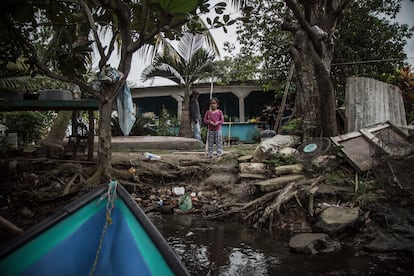
Like the pre-Hispanic peoples who settled thousands of years ago in this region of the state of Veracruz, Mexico, the residents of Mano Perdida, a rural community located among the wetlands of the Alvarado Lagoon System, are governed by a water calendar. In it, two seasons mark a way of life linked to the cycles of nature: the rainy season, which usually arrives at the end of September, with the turbulent, greenish currents, when the roads that interconnect the municipalities are flooded, “and the dry season, which begins in April or May, in the months when we consume the most water and get the most profits from fishing,” says Felipe Ramírez, 72 years old. The gaze of the old man, who protects himself from the sun with a cowboy hat, is fixed on a circular map that is spread out on the table where the fishing cooperative he presides meets.
In the center of the map, different drawings depict community knowledge according to the month. A red thermometer to represent the hottest days. A blue drop for when the water is cleaner. A black one warns that the water comes out of the taps dirtier. The silhouette of a well as a reminder that the community’s water tank must be cleaned with chlorine every three months. Information that the group of researchers that make up the Water Reserve Monitoring Network (RedMORA) is turning into socio-environmental data. The goal of this scientific project is to measure, in a technical, precise way, the conditions of the ecosystems in which the inhabitants of Bajo Papaloapan live, plains where the Olmecs and other cultures of the Gulf of Mexico settled more than a century ago. This is the place where the Jarocha tradition of Veracruz was later developed, “the set of sociocultural traits that resulted from the coexistence between indigenous and Spanish societies, African roots and other migratory influences that created this cultural wealth that is so typical of the Veracruz tropics,” explains Xochitl del A. León Estrada, an anthropologist and archaeologist that was born in the state.
This basin, which originates between the tropical jungles and the temperate forests of Oaxaca and flows into the central-southern region of the State of Veracruz, is the second most important in Mexico. “Although this area has not been explored much compared to others, multiple archaeological finds have been discovered there, pre-Hispanic vestiges that remain under the undergrowth, as well as obsidian utensils for scaling fish, among other pieces of immense historical value that reveal how the ancient inhabitants of the mangroves already subsisted thanks to the aquatic resources of the region,” explains León Estrada, who is part of the group of experts that is analyzing the effects of pollution on the ecosystems of Bajo Papaloapan and on riverine fishing.
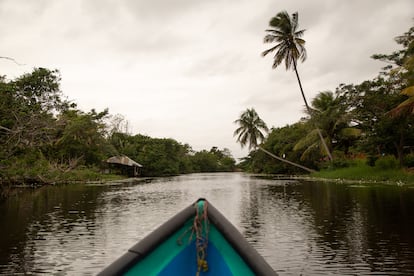
This activity is the main means of subsistence in Mano Perdida, a small piece of land with just over 200 inhabitants, where property is mostly communal and which is accessed by an asphalt road connected to the highway that winds along the river Papaloapan (“river of butterflies” in Nahuatl). The quality of the water that flows through the ecosystems is being affected by the pollution caused by sugar cane plantations around the communities, a million-dollar business that devours more of the natural landscape every day.
According to Patricia Moreno-Casasola, a researcher at the Institute of Ecology (Inecol), this industry is encroaching on fishing habitats and putting people’s health at risk. “The runoff from herbicides and other chemicals used in sugarcane cultivation is carried from the Acula River to the Alvarado lagoon, causing terrible ecological damage, not only to surface waters — it also filters into the groundwater,” says the environmentalist. In addition to the alcohol products that are made from its cultivation, sugarcane is planted mainly to export millions of tons of fructose. The United States is its main buyer.
To eradicate pests like the screwworm, cane producers use Furadan, one of the most toxic pesticides available. In some water samples, “atrazine, a very dangerous chemical for the environment and the aquatic organisms, has also been found,” highlights the scientist from RedMORA. In the calendar made by the inhabitants and scientists, the months in which the effects are most severe are noted. “Harvest season starts in December, but it is in October when the factories wash and the water arrives dirtier, due to the rains and the tides,” says Beatriz Zamudio, a member of the fishing cooperative, who learned the trade from her father when she was 6 years old.
“He used to take me on his boat since I was little,” says the woman, who now has two daughters and one granddaughter and supports the entire family with the money that she makes every day on her little boat. “It’s what I always did,” she continues. “My dad instilled in me from a very young age the importance of being independent, of not needing a man to survive. That’s what he used to tell me, and I always followed his advice. I only spend to invest in material, to make my own traps,” she explains as she points to the fishing nets that hang at the entrance of her home.
Zamudio’s home stands on a patch of land along the canals that intertwine the lagoons like water tongues. A small house that every day is visited by herons, pelicans, cranes... the biodiversity that surrounds the corral, at the water’s edge, where the fisherwoman keeps the breeding animals: chickens, ducks, two pigs. “From the sale of the first pig, I bought my daughters’ uniforms and was able to pay for their school registration. I didn’t go to school, that’s why I know that education is very important, and I invest in it so that they study and don’t have to work as hard as I do,” says Zamudio proudly, as she maneuvers her boat through the mangroves.
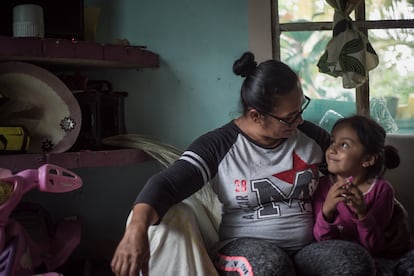
While many territories in Mexico suffer serious droughts, here water is abundant, so much so that during the stormy season a latent risk of flooding looms over the community. “The thing is that the water is not clean, so we have to buy it in jugs,” laments the fisherwoman. The only well built in Mano Perdida is dry and, like the rest of the communities settled around the wetlands, they have no access to quality water, so people have to buy it from purifiers located in distant cities. “We use a lot of water to drink and cook, and sometimes we go several consecutive days without it because they take a long time to bring us the jugs. We only use the tank water to bathe and wash, but it is very dirty,” she explains.
In addition to the pollution generated by the overuse of fertilizers and herbicides for sugarcane and other crops, other problems are causing the daily life of the people of Bajo Papaloapan to collapse, such as those derived from the drastic changes in land use that can be observed in the landscape, where a mosaic unfurls: mangrove lagoon, tule, sapotes, a small pond and pastures, areas of native vegetation altered by uncontrolled livestock exploitation. This part of Veracruz has one of the most serious deforestation rates of all the pilot sites of the National Commission for the Knowledge and Use of Biodiversity (Conabio). As in so many other places in Latin America, the Alvarado wetlands are transformed into flooded pastures for cattle grazing, an activity that began in the 1970s. “And in which many chemicals are also used, tickicides, for example,” says Moreno-Casasola. Deforestation does not only occur near lagoons. “One of the problems that worry us the most is silting,” says the environmentalist, referring to the sediments caused by the erosion of soils that suffered the removal of their forest layer.
Throughout the year, the tributary that flows into this lagoon complex travels from the upper area of the basin, the mountains of Oaxaca, dragging in its path pollutants that accumulate on the coast of Veracruz. However, the scientist explains, “with the arrival of the cold, the rain and the north winds in November, the waters run turbulent and black due to siltation, a phenomenon that reduces the capture of shrimp, crab and tilapia.”
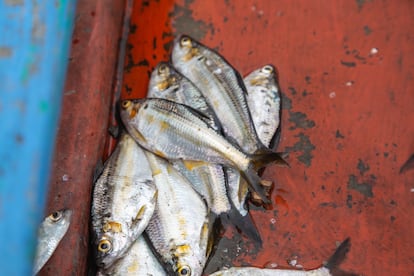
The people of Mano Perdida live off these fish products all year round. “There are others that are seasonal. From June to August it’s bass spawning season, for example. And the harvest of nacara has just finished,” explains Ramírez. The capture of this unique fish, harvested for its roe, “is a custom that comes from pre-Hispanic times, along with other traditions that tell how various cultural groups used the river flows for the trade of fishing products, from the Gulf Coast to the Central Highlands region,” says León Estrada.
The unique biocultural ecosystem of Bajo Papaloapan, its biodiversity and balance, are being increasingly affected by deforestation, drastic changes in land use, the overuse of fertilizers and herbicides used in sugarcane cultivation, uncontrolled livestock exploitation and the dismal quality of water that jeopardizes the health of the inhabitants of Mano Perdida. The community is now fighting to recover the symbiotic human-nature relationship to the sounds of the water flows created so long ago in these plains.
Sign up for our weekly newsletter to get more English-language news coverage from EL PAÍS USA Edition
Tu suscripción se está usando en otro dispositivo
¿Quieres añadir otro usuario a tu suscripción?
Si continúas leyendo en este dispositivo, no se podrá leer en el otro.
FlechaTu suscripción se está usando en otro dispositivo y solo puedes acceder a EL PAÍS desde un dispositivo a la vez.
Si quieres compartir tu cuenta, cambia tu suscripción a la modalidad Premium, así podrás añadir otro usuario. Cada uno accederá con su propia cuenta de email, lo que os permitirá personalizar vuestra experiencia en EL PAÍS.
¿Tienes una suscripción de empresa? Accede aquí para contratar más cuentas.
En el caso de no saber quién está usando tu cuenta, te recomendamos cambiar tu contraseña aquí.
Si decides continuar compartiendo tu cuenta, este mensaje se mostrará en tu dispositivo y en el de la otra persona que está usando tu cuenta de forma indefinida, afectando a tu experiencia de lectura. Puedes consultar aquí los términos y condiciones de la suscripción digital.
More information
Archived In
Últimas noticias
Welcome to the post-religion era: The idea of Christianity as the absolute truth has become obsolete
‘I thought you would like it’: The risky sexual practice popularized by TV shows and TikTok
The digitalization of tourism: ‘They promise experiences and gave us the worst possible one’
Mexican peso defies uncertainty with forecasts of a new period of stability in 2026
Most viewed
- Sinaloa Cartel war is taking its toll on Los Chapitos
- Reinhard Genzel, Nobel laureate in physics: ‘One-minute videos will never give you the truth’
- Oona Chaplin: ‘I told James Cameron that I was living in a treehouse and starting a permaculture project with a friend’
- Why the price of coffee has skyrocketed: from Brazilian plantations to specialty coffee houses
- Silver prices are going crazy: This is what’s fueling the rally
